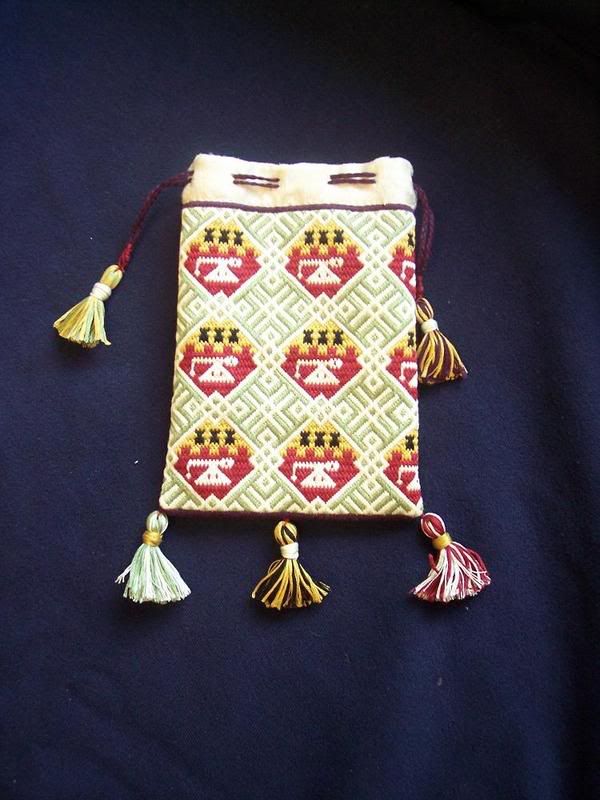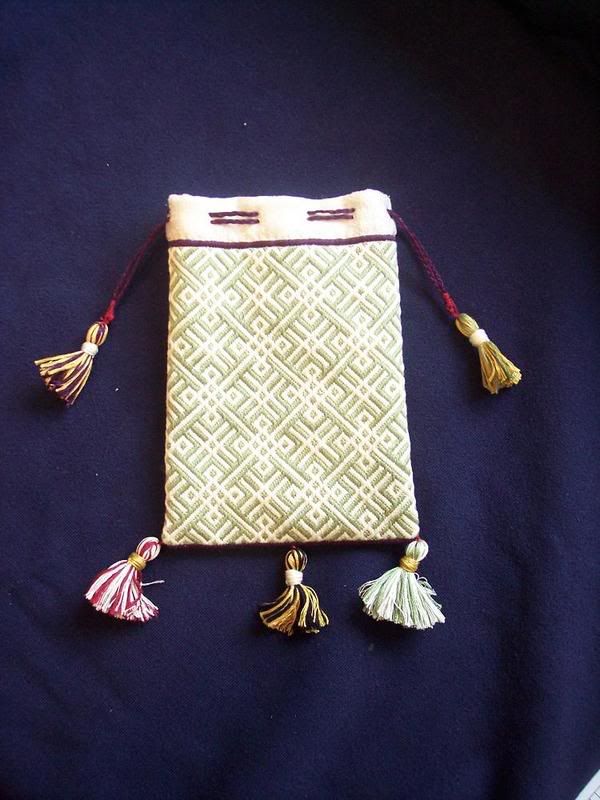 ...I'll show off an old one. My first completed purse worked in the brick-stitch (sometimes referred to as opus teutonicum although I'm not entirely sure that's precise.. any comments here?)
...I'll show off an old one. My first completed purse worked in the brick-stitch (sometimes referred to as opus teutonicum although I'm not entirely sure that's precise.. any comments here?)Worked in 6-strand cotton embroidery floss on 28-ct cotton evenweave, no seam on the bottom. The heraldic elements were adapted from the arms I display at living history events (e.g. SCA), and only appear on one side of the purse (which I consider the "front" side). The lining is white silk brocade that I had lying aroud.
Self-critizism:
- Not going to get into the cotton vs silk/linen issue here, as it was my 1st attempt and I was/am a poor student :-)
- As far as construction is concerned, I made this before I fully understood the more historically common treatments of the seams (e.g. the "Gobelien stitch".. not sure if I spelled that correctly).
- I understand now that tassle heads were rarely (if ever) left uncovered.
- With the above comment in mind, my treatement of the attachement between drawstrings and tassles could've been a bit more thought-out..
- Lacks a suspension cord.
Some things I learned from this:
- Why the suspension loop is a good idea. (Because if you suspend it from the drawstrings, you will anger yourself every time you try to fish something out of it.)
- How to assimilate designs to 'fit' the style: better to lose some of the 'realism' of the design (e.g. my heraldic trebucht) in order to achieve a consistent look to the piece. It's easier for me to intuit this than to put it into writing. At least for now.





1 comment:
Here are a couple places with information about opus teutonicum (German work). It is mostly white, but many older b/w photos show it as black on white because of the use of backlighting for purposes of making the design show up in the photo. Some of the example available on bildindex are like this. Some embroideries (after the 13th century per the West Kingdom Needle article listed below) were white on white linen with colored silk accents. A couple of posts ago on my blog is an example of an embroidery with white and colored silks showing both the older b/w photo and a newer color photo.
http://www.bayrose.org/wkneedle/Articles/Whitework.html
http://www.feelingstitchy.com/2007/04/opus-teutonicum.html
If you haven't seen this site you should take a look. It has a lot of information on a wide variety of medieval embroidery:
http://medieval.webcon.net.au/technique_opus_teutonicum.html
Your purse is beautiful! I like how you incorporated the heraldic element into the front side of the embroidery.
There is definitely a lot of information about how to finish up the side seams if you are unsatisfied with how you did that. And it IS annoying if the drawstring is also the cord used to hang the purse. My next purse will have two separate cords. If you have more older work you should post pictures!
Post a Comment